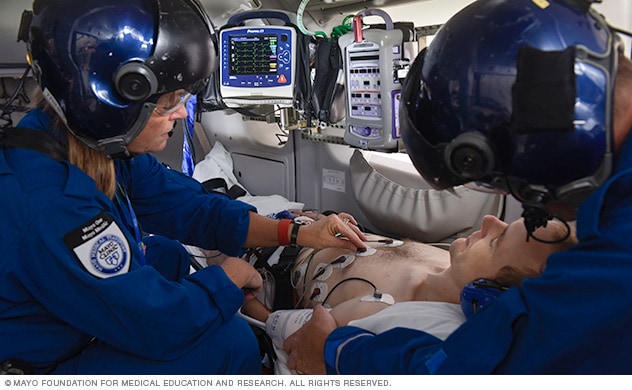Everything You Need to Know Aobut Ekgs
Overview
An electrocardiogram records the electrical signals in the center. It's a common and painless test used to apace detect heart problems and monitor the heart'due south health.
An electrocardiogram — also called ECG or EKG — is often done in a health care provider'southward office, a clinic or a hospital room. ECG machines are standard equipment in operating rooms and ambulances. Some personal devices, such as smartwatches, offer ECG monitoring. Ask your wellness care provider if this is an option for you.
Types
- Holter monitor
- Implantable loop recorder: A heart monitoring device
Why it's done
An electrocardiogram is a painless, noninvasive way to assistance diagnose many mutual centre bug. A health care provider might apply an electrocardiogram to decide or discover:
- Irregular heart rhythms (arrhythmias)
- If blocked or narrowed arteries in the heart (coronary artery disease) are causing breast hurting or a centre attack
- Whether you have had a previous heart assault
- How well sure heart disease treatments, such as a pacemaker, are working
You may need an ECG if you accept whatever of the following signs and symptoms:
- Chest hurting
- Dizziness, lightheadedness or confusion
- Centre palpitations
- Rapid pulse
- Shortness of breath
- Weakness, fatigue or a decline in power to exercise
The American Center Association doesn't recommend using electrocardiograms to assess adults at low take a chance who don't have symptoms. But if you accept a family history of heart disease, your wellness care provider might suggest an electrocardiogram equally a screening exam, even if you lot accept no symptoms.
If symptoms tend to come and go, they may not be detected during a standard ECG recording. A health care provider might recommend remote or continuous ECG monitoring. There are several different types.
- Holter monitor. A Holter monitor is a pocket-size, wearable device that records a continuous ECG, normally for 24 to 48 hours.
- Event monitor. This portable device is similar to a Holter monitor, but information technology records just at certain times for a few minutes at a time. You can wear information technology longer than a Holter monitor, typically 30 days. You generally push a button when you feel symptoms. Some devices automatically record when an irregular rhythm is detected.
 ECG on medical helicopter
ECG on medical helicopter
A person receives an ECG while on a helicopter for medical transport.
Risks
An electrocardiogram is a rubber procedure. In that location is no take chances of electrical daze during the exam because the electrodes used exercise not produce electricity. The electrodes only record the electrical activity of the heart.
You may have minor discomfort, similar to removing a bandage, when the electrodes are removed. Some people develop a slight rash where the patches were placed.
How you set up
No special preparations are necessary for a standard electrocardiogram. Tell your health care provider about any medications and supplements you have. These can often affect the results of an ECG.
What yous can look
An electrocardiogram can exist done in a wellness care provider'south role or hospital.
Earlier
Y'all may be asked to change into a hospital gown. If you take pilus on the parts of your body where the electrodes will be placed, the care provider may shave the hair so that the patches stick.
Once you're set up, you'll typically be asked to lie on an examining table or bed.
During
During an ECG, up to 12 sensors (electrodes) are attached to the chest and limbs. The electrodes are sticky patches with wires that connect to a monitor. They tape the electrical signals that brand the eye beat. A computer records the information and displays information technology as waves on a monitor or on paper.
You tin breathe during the test, but you will demand to lie nonetheless. Make sure you're warm and ready to lie still. Moving, talking or shivering may interfere with the examination results. A standard ECG takes a few minutes.
Afterwards
You lot can typically render to your usual activities later your electrocardiogram.
Results
Your health care provider might discuss results with yous the aforementioned day as your electrocardiogram or at your adjacent appointment.
ECG results can give a health care provider details almost the following:
- Center rate. Usually, eye charge per unit tin can be measured past checking the pulse. An ECG may be helpful if your pulse is difficult to experience or too fast or too irregular to count accurately. An ECG can assist identify an unusually fast middle charge per unit (tachycardia) or an unusually slow centre rate (bradycardia).
- Middle rhythm. An ECG can detect irregular heartbeats (arrhythmias). An arrhythmia may occur when any part of the heart's electrical system doesn't piece of work properly.
- Heart attack. An ECG can prove evidence of a previous heart attack or i that'south currently happening. The patterns on the ECG may help make up one's mind which office of the heart has been damaged, equally well as the extent of the damage.
- Blood and oxygen supply to the heart. An ECG done while you're having symptoms can aid your wellness care provider determine whether reduced blood flow to the heart muscle is causing the chest hurting.
- Center structure changes. An ECG tin can provide clues about an enlarged heart, heart defects and other heart issues.
If results show a heart rhythm problem, yous may demand another ECG or other test, such every bit an echocardiogram. Treatment depends on what'southward causing your signs and symptoms.
Clinical trials
Explore Mayo Clinic studies of tests and procedures to assistance foreclose, find, care for or manage conditions.
christianoexped1936.blogspot.com
Source: https://www.mayoclinic.org/tests-procedures/ekg/about/pac-20384983
0 Response to "Everything You Need to Know Aobut Ekgs"
Post a Comment